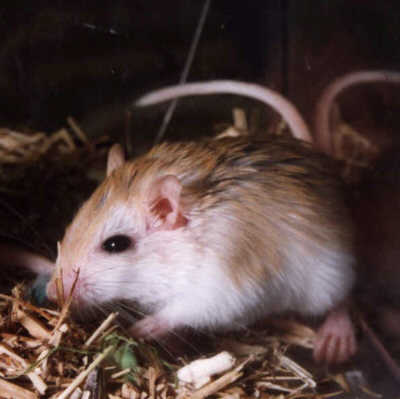
The Egyptian Gerbil
By Julian Barker
This article first appeared in the June 2000 issue of The Nibbler -
Journal of the National Gerbil Society
The species often called The Egyptian Gerbil (Gerbillus gerbillus)
is better referred to as The Lesser Egyptian Gerbil to avoid confusion with The
Greater Egyptian Gerbil (G. pyramidum). It is a much smaller gerbil
than the various species normally kept as pets. From nose to the tip of the tail
the very largest adults are no more than 230mm (9 inches). A more typical length
is only just over 200mm (8 inches). The body is often no more than 90mm long
(3.5 inches). The tail is on average over a third longer than the body.
In appearance, they look very much like Pallid Gerbils
(G. perpallidus), but they are significantly smaller. The coat on their
back is a sandy buff colour, but the precise shade will, as is often the case in
desert rodents, depend on the colour of the soil and rocks in the region where
they or their ancestors were captured. The belly is white, and the white comes
up a long way on the sides and head. So much so that the eyes and mouth are
ringed with white. Like Pallid gerbils the Lesser Egyptian Gerbil has a much
more fine-boned appearance than the Mongolian Gerbil (Meriones
unguiculatus). This appearance is born out by their average weight which is
only 23g (less than an ounce), and is about a third of the weight of a Mongolian
Gerbil. The ears are unpigmented and are shorter than is often the case with
Gerbillus species. The tail is well covered in hair and has tip of longer darker
hairs
They live in a large range across North Africa and the Middle East. From
Morocco in the west to Sinai, Southern Jordan and parts of North-western Arabia,
and as far south as Chad, Niger, Mali, and Uganda. They are one of the most
common desert rodents in desert and semi-desert regions of Egypt, Sinai, and
much of the Sahara. Egyptian Gerbils often live in very remote areas where
rainfall is sparse. This means that the population level can vary greatly from
year to year as the rains come and go. This has helped lead to a great diversity
in this species. There are many recognised races of Lesser Egyptian Gerbils
which vary from one another in various ways.
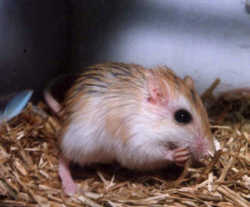
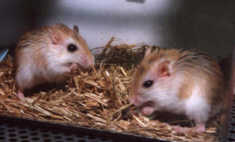
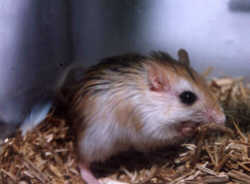
The preferred habitat is sandy dunes. They have furred soles of their feet to
help them make progress on the shifting sands. They are also common along the
Nile Valley where live in sandy patches between palm groves and cultivated
areas. Across North Africa they are far more common in the dunes, although they
avoid the large sand seas. They are much less common in coastal areas where
other species of gerbils predominate. They particularly like to burrow in areas
of windblown sand and where sand has accumulated to cover rubbish dumps or
abandoned buildings. They often live immediately alongside other gerbil species
such as Anderson's Gerbil (G. andersoni), Sundervall's
Jird (M. crassus) and The Greater Egyptian
Gerbil. They also live alongside jerboas such as Jaculus jaculus.
Although almost nothing is known about how Lesser Egyptian Gerbils interact with
these other species.
It has been noted that Lesser Egyptian Gerbils will avoid leaving sandy
areas. For example, in a study of desert rodents Baluchistan
Gerbils (G. nanus) who live normally on salt flats, would also be
sometimes found in the neighbouring dunes. But the Lesser Egyptian Gerbils that
lived in the dunes would never venture onto the slat flats.
The burrows of Lesser Egyptian Gerbils vary depending on the time of year but
are usually about 600mm deep (about 2 feet). They can be some 4.5 metres (14
feet) long with branching passageways and stores of food and nesting material.
The burrow allows the gerbils to protect themselves from the extremes of
temperature. In one study carried out in January, surface temperature varied
from 8C to 27C in a single day, temperature in the burrow stayed between 12 and
14.5C. Humidity in burrows is also high. During the same study outside humidity
dropped as low as 15%. Humidity in the burrow stayed between 81 and 100%. The
Lesser Egyptian Gerbil is a very social animal and a burrow can contain many
gerbils.
Lesser Egyptian Gerbils are attracted by campsites, fallen dates and camel
dung, and will often bite when first captured in the wild. However, on repeated
handling they soon become tame. The diet appears to consist entirely of seeds,
fruits, leaves and buds. Camel dung is torn apart looking for undigested seeds.
They have been known to enter inhabited dwellings looking for food and shelter.
The breeding season is between January to May and litter size appears to be
between three and six. This gerbil is active throughout the year, and in
experiments, they have shown a homing ability. If artificially displaced from
their burrows, they can successfully return to them.
Finally, the Lesser Egyptian Gerbil has one characteristic that no other
Gerbil species can boast. It has been featured on a postage stamp! In 1992, as
part of a series of stamps displaying a variety of rodents, Vietnam issued this
4000 Dong stamp.
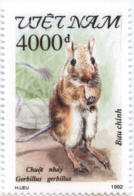
References:
THE MAMMALS OF ARABIA (Second Edition), Harrison DL, Bates PJJ, Harrison
Zoological Museum Publication, 1991, 268-305
DESERT COLOURATION IN RODENTS: David L Harrision, 1975
EAST AFRICAN MAMMALS, VOL IIB., Kingdom, J., Academic Press, London., 1974, ,
507-18
MAMMALS OF ALGERIA, Kowalski, K. Rzebik-Kowalska, B. Zaklad Narodowy Imienia
Ossolinskich Wydawnictwo Polskiej Akademii Nauk Wroclaw, Poland., 1991, 219-53
RODENTS IN DESERT ENVIRONMENTS, Chapter XIII, Prakash, L and Gosh, P.K.
(volume editors)., Dr W. Junk b.v. Publishers, The Hague, 1975, 90 6193 080 4
THE CONTEMPORARY LAND ANIMALS OF EGYPT (INCLUDING SINAI). (Fieldiana Zoology,
no. 5), Osborn, D.J. & Helmy, I, 1980, 94-245
RODENTS OF LIBYA: Rank G. L., 1968, U.S. National Museum Bulletin, 275
THE RODENTS OF WEST AFRICA, Rosevear, D.R, British Museum (Natural History),
London, 1969, 198-212
NOTES ON MAMMALS FROM THE NILE DELTA REGION OF EGYPT, Setzer W. H.,
Smithsonian Institute, 1952
MAMMALS OF THE ANGO-EGYPTIAN SUDAN, Setzer H. W., Smithsonian Institute, 1956
THE MAMMALS OF SOUTH SINAI, EGYPT: Wassif K., Hoogstraal H., 63-79




























Return to the NGS Homepage?
The views presented on this page are not necessarily those of the National
Gerbil Society.
Please note that the material on these webpages is covered by copyright law.
If you wish to use any pictures etc for anything other than your personal
private use, such as publishing material on a website, then
This web page may include links to other web sites. These links are provided
in order to enhance the interest and usefulness of other content and are not
intended to signify that the National Gerbil Society, or the authors of material
featured on the NGS Website, endorses or otherwise has any responsibility for
the content of any linked web page, web site or other linked material.
This page has been constructed by
Telephone number for media contact only - (+44)
07941893143
Last updated 22 September 2007





